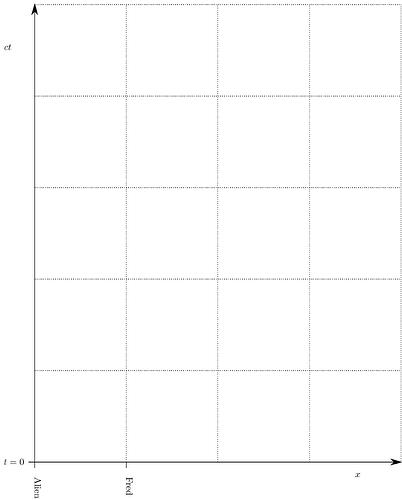When studying problems in special relativity it is often the invariant distance \Delta s between two events that is most important, where \Delta s is defined by
where c=3 \times 10^{8} \mathrm{~m} / \mathrm{s} is the speed of light. { }^{1}
a. Consider the motion of a projectile launched with initial speed v_{0} at angle of \theta_{0} above the horizontal. Assume that g, the acceleration of free fall, is constant for the motion of the projectile.
i. Derive an expression for the invariant distance of the projectile as a function of time t as measured from the launch, assuming that it is launched at t=0. Express your answer as a function of any or all of \theta_{0}, v_{0}, c, g, and t.
ii. The radius of curvature of an object’s trajectory can be estimated by assuming that the trajectory is part of a circle, determining the distance between the end points, and measuring the maximum height above the straight line that connects the endpoints. Assuming that we mean “invariant distance” as defined above, find the radius of curvature of the projectile’s trajectory as a function of any or all of \theta_{0}, v_{0}, c, and g. Assume that the projectile lands at the same level from which it was launched, and assume that the motion is not relativistic, so v_{0} \ll c, and you can neglect terms with v / c compared to terms without.
b. A rocket ship far from any gravitational mass is accelerating in the positive x direction at a constant rate g, as measured by someone inside the ship. Spaceman Fred at the right end of the rocket aims a laser pointer toward an alien at the left end of the rocket. The two are separated by a distance d such that d g \ll c^{2}; you can safely ignore terms of the form \left(d g / c^{2}\right)^{2}.
i. Sketch a graph of the motion of both Fred and the alien on the space-time diagram provided in the answer sheet. The graph is not meant to be drawn to scale. Note that t and x are reversed from a traditional graph. Assume that the rocket has velocity v=0 at time t=0 and is located at position x=0. Clearly indicate any asymptotes, and the slopes of these asymptotes. The graph is not meant to be drawn to scale. Note that t and x are reversed from a traditional graph. Assume that the rocket has velocity v=0 at time t=0 and is located at position x=0. Clearly indicate any asymptotes, and the slopes of these asymptotes.
ii. If the frequency of the laser pointer as measured by Fred is f_{1}, determine the frequency of the laser pointer as observed by the alien. It is reasonable to assume that f_{1} \gg c / d.
{1} We are using the convention used by Einstein.
Following is the answer sheet for some of the graphical portions of the question.
Space-time graph for accelerated rocket. The positions of Fred and the Alien at t = 0 are shown.
